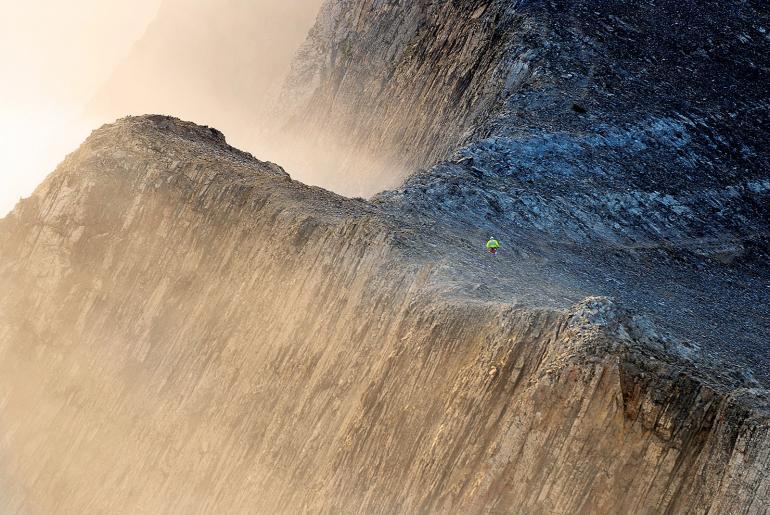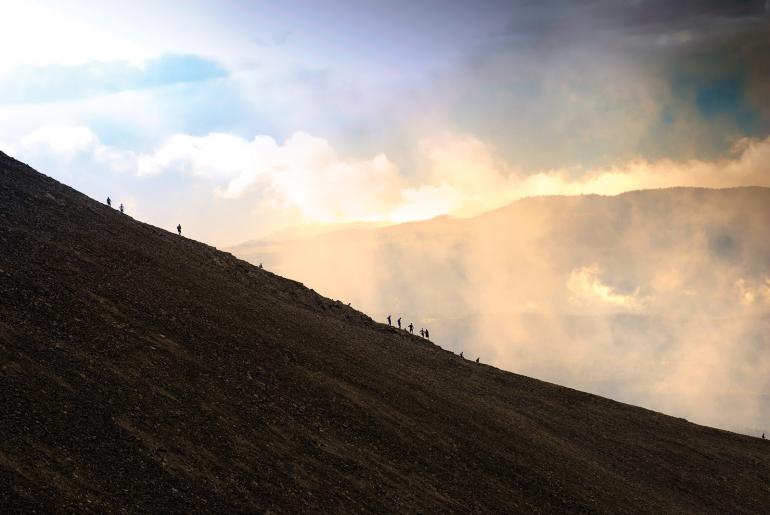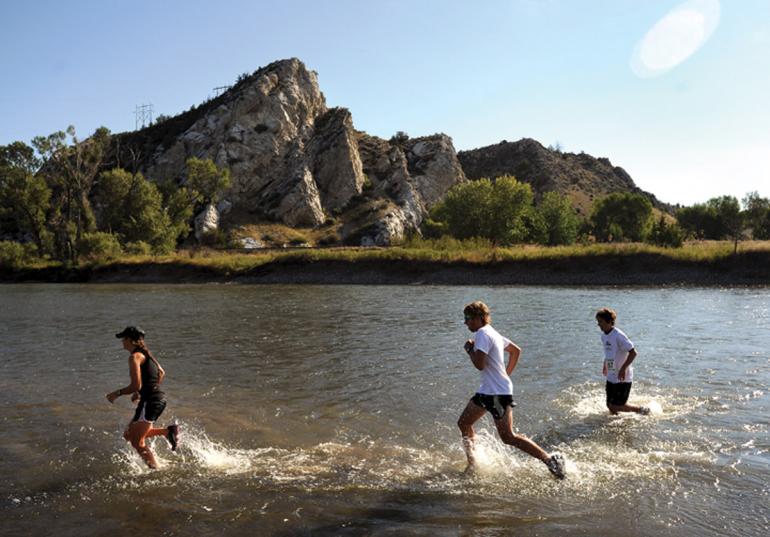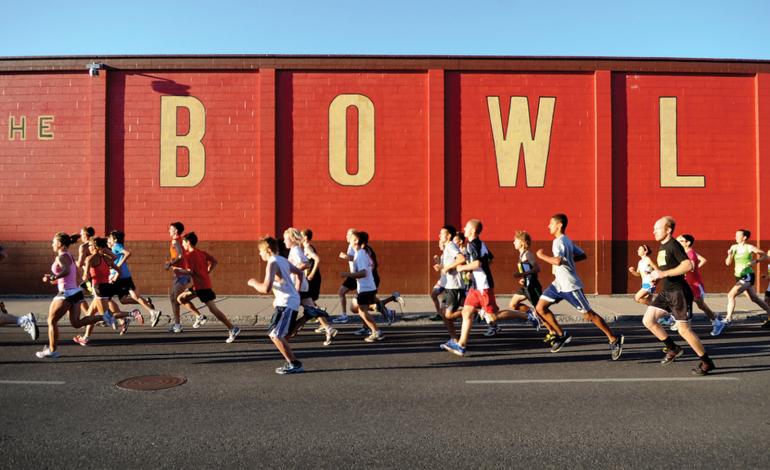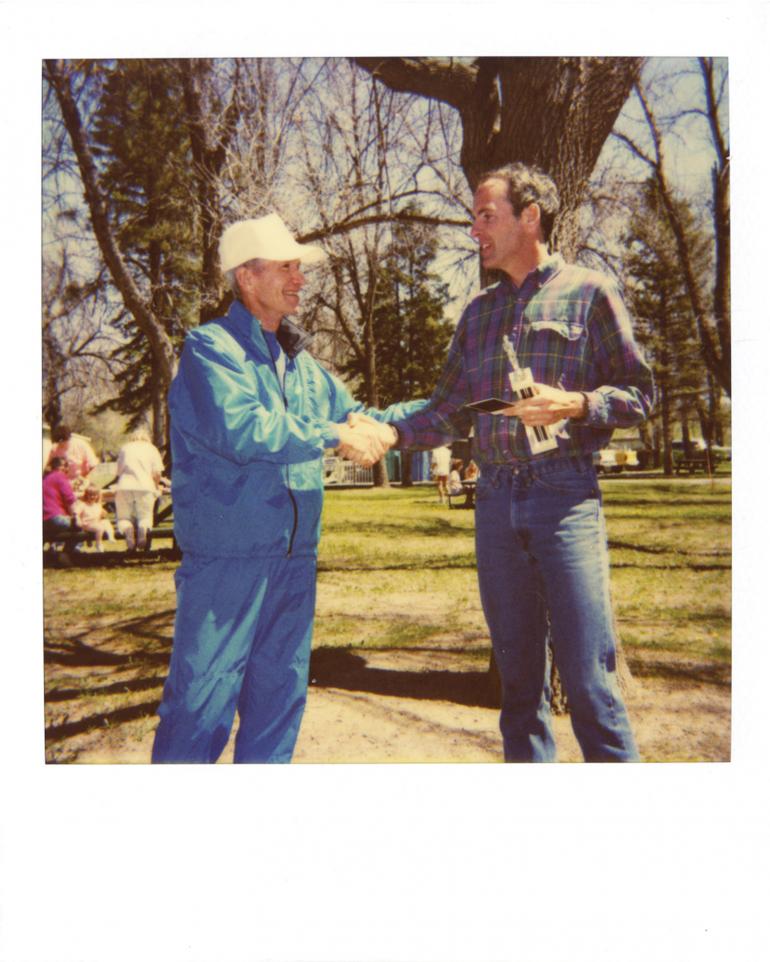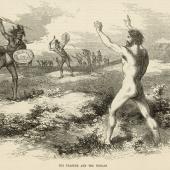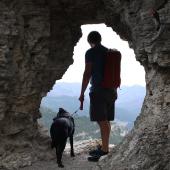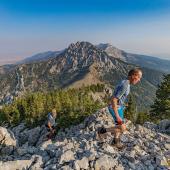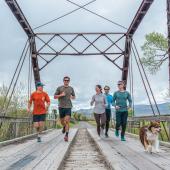Fitness Must Be Earned
The history of Big Sky Wind Drinkers.
A sprawling mass of letters, newspapers, photos, and scribbled, scrap-paper notes covers Kay Newman’s kitchen table. A thick three-ring binder plops down with a thud. The binder bulges with every news clipping, photograph, and race result in the history of the Big Sky Wind Drinkers, Bozeman’s first running club. Founded in 1973, the club, like Kay, is still kicking today. She explains that she is not related to Wind Drinkers co-founder Frank Newman—even though they used to laugh about how she was his “second wife.”
The binder contains thousands of entries, and it’s my job to sift through the daunting collection and extract only the most relevant information. I shift a little uneasily in my chair; its plastic-covered seat squeaks in protest. Kay smiles and says, “This one is just from ’87 to ‘89. I have several more binders downstairs. Would you like to see them?”
The Men Behind the Napkin
It was the summer of 1973 in Red Lodge, Montana, and unless you were running from something, you were considered strange. Club founders Andy Blank and Frank Newman, both staff members at MSU-Bozeman, were carbo-loading at Natalie’s, discussing their strategies for the Beartooth Run the next morning. Hovering over a bowl of pasta, Andy was still wearing his orange short shorts from an evening run (to be fair, all shorts were short then). He had 200 pounds packed on his six-foot frame—not your typical runner, even when runners weren’t typical. Frank, on the other hand, was a lithe five-foot-seven, his hair already turning its unique silver hue—built like a runner before running was sane.
They’d both participated in the Beartooth Run since its inception four years prior in 1969, but it had never been an easy 8.2 miles. With 2,000 feet of elevation gain, even a competitive runner could find himself recording a sluggish eight-minute-mile pace. Despite steep climbs and thin air, the competition brought them back year after year.
They decided over dinner that they wanted to do more than just run—they wanted to spread its gospel. They wanted to create a group that motivated people to run, encouraged competition, and forged relationships. Then Andy had a flash of inspiration. Frank grabbed the least-soiled napkin on the table and, choosing his words carefully, penned the now-famous charter:
Be it known that on 30 June 1973 Frank Newman & Andy Blank in Red Lodge, Montana organized the, yet to be named, club in the interest of promoting physical fitness through running/jogging & competition. Although physical fitness is the aim it is recognized that individuals will differ in their prowess & adroitness as runners. Therefore, it is not important how fast one runs but that one runs.
The men both signed their names and then called over the waitress. After she signed her own name as a witness to the historic event, Bozeman’s first running club was born.
Drinkers of the Wind
With the Beartooth Run behind them and the future of the club uncertain, Andy and Frank, along with eight other Bozemanites, organized their first competition in September 1973. By then, the club was tentatively referred to as the “Wind Drinkers,” based on a book called Drinkers of the Wind—a novel about wild Arabian horses bred for their endurance and speed. “The name was probably an idea generated by Andy Blank,” Frank would later write, in his characteristically self-effacing way.
The competition was a Super Relay—a 24-hour, mind-numbing, body-rending, spirit-crushing bitch of a race. The Wind Drinkers got the idea from Runner’s World magazine: a team of ten or fewer runners would take one-mile shifts on a standard oval track. The relay would start at a scheduled time and continue uninterrupted for 24 hours; if a runner had to drop out, the remaining members would continue in the scheduled sequence.
It was in this newsletter that the motto of the Wind Drinkers first appeared: ‘Fitness cannot be bestowed or bought; like honor, it must be earned.’
At 4pm, the team gathered at the starting line with cots, sleeping bags, drinks, food, and gear. Nine men and one woman competed, waiting for their turn to move the baton, nursing stomach cramps and stiff quads in the meantime. Propane lanterns illuminated the old track as they ran through the cold night. Member and one-time president Kay Newman recalls the race was a “real killer.”
“You’d just about get to sleep and somebody would come up and say, ‘You’re up next’,” Kay says. “The men got so grumpy.” And perhaps even worse than grumpy old men, the laps never changed direction. “You never got to rest that other knee,” she says. “It was always leaning in!”
But the team went on to finish, with no casualties and a fierce pride that would hold together the young club. They completed 216.6 miles on the Manhattan High School track, and even got a mention in the Bozeman Daily Chronicle—in an article appropriately titled “They Ran and Ran and Ran and Ran…”
Off & Running
Over the next two years, the Wind Drinkers sponsored a number of runs—the Bridger Bowl Run, the Turkey Trot, the Governor’s Cup Marathon—but the club itself was dormant. Then, on July 8, 1975, the Big Sky Wind Drinkers met for the first time as an official club on the MSU campus.
Along with the first meeting came the first newsletter—now a Wind Drinkers trademark, in its 400th edition. It was and still is published by Jim Banks, a charter member of the club. “Having a monthly newsletter has helped the club succeed, because people are aware of what’s going on,” Jim says. “We pay attention to people.”
The closing sentences of the first newsletter read:
You are fortunate to receive a copy of this historic document. It is being reproduced in only fifty copies and will surely become a much sought after collectors’ item of great worth within a short period of time.
It was in this newsletter that the motto of the Wind Drinkers first appeared: “Fitness cannot be bestowed or bought; like honor, it must be earned.”
The club would go on to host some of the most enduring running events in Bozeman, or what they refer to as the “Big Three”: the Bozeman Classic, the John Colter Run, and the Bridger Ridge Run. The Bozeman Classic, a 5k/10k race, began as part of the Sweet Pea Festival in 1978, and is one of the biggest races held in Bozeman. This year’s race, the 34th annual, has been renamed the “Bozeman Stampede” by the Wind Drinkers to reflect the club’s galloping-horse logo.
The John Colter run, marking its 35th anniversary this year, honors the storied mountain man’s famous escape from the Blackfeet Indians in 1809. Held at Missouri Headwaters State Park, this cross-country footrace covers seven miles over rugged trails, gravel, and even across the Gallatin River. The course was originally designed by Frank and Andy—as Frank’s son Eric Newman says, “The stakes that mark it are probably the original stakes they set there 35 years ago.
The last of the “Big Three,” named for the late Ed Anacker, a charter member of the Wind Drinkers and one-time president, the Ed Anacker Bridger Ridge Run is an agonizing 20-mile run along treacherous mountain terrain. Eric remembers the first time his dad and Ed ran that trail together. “My mom said, ‘Do you know where dad is?’ And I shook my head. She just pointed to the ridge and said, ‘Up there. He’s going for a run.’” Eric adds that despite the absence of a real trail back then, “My mom picked him up at the M five hours later.”
Frank Newman & His Legacy
In 1988, Ed decided to create a relay event to honor Frank. The race, which runs from Bridger Canyon Road in Bozeman to Livingston via the frontage road, has morphed from a relay into a marathon and half-marathon course, one of the only of its kind in Montana. “Dad used to call it the cheapest and the shortest marathon around,” Eric says, chuckling, because the course was never officially measured and the entry fee was only $3. “He drove the course in his car and just used the odometer to measure it.”
But that didn’t stop people from showing up to the race—except for Frank, who wasn’t in town for the first annual run that bears his name. And Andy, who by that time had moved—Eric jokes that he didn’t come back for the race because “he moved to Texas and gained a hundred pounds and was too embarrassed to come back.” But other runners came, and nearly every year since, the race has hosted a “50-stater”—a runner whose goal is to finish a marathon in every state—which is a good barometer for the status of marathons in Montana.
In November of 2011, Frank passed away due to complications from pneumonia. In Frank’s memory, his family is paying for the whole race this year—entry fees, t-shirts, coffee mugs, and Pickle Barrel sandwiches at the finish. Frank always thought of the marathon as a fun run, because it took pressure off the runners and made the race less expensive to coordinate—which was all in his nature.
“He was a believer in running for health and for mental health,” says Lori, Eric’s wife and Frank’s daughter-in-law. “When he knew that one of us was dealing with something, he would encourage us to run more because that was going to fix it.” Frank believed that running was for everybody, and you didn’t have to be good at it to enjoy its benefits. He, on the other hand, kept a much higher standard for himself.
‘When Frank knew that one of us was dealing with something, he would encourage us to run more because that was going to fix it.’
In an issue of High Country Runner, Frank wrote, “I’m aware of the fringe benefits of running, but in truth, I run primarily for the competition.” He ran between 40 and 60 miles per week when he was still competing, rising at a quarter to six every morning, regardless of the weather. “He was hard on himself,” Eric says. And, naturally, he was unhappy in his last years when he couldn’t run anymore. “But he always kept his spirits up, there was no question,” Jim says. “He never felt sorry for himself.”
Frank grew up in Kansas, and would later go on to be a Marine in the Korean War. “He exercised all the time,” Eric says. “He was a Marine because it exemplified the physically fit ethic that he had.” Frank was the kind of guy who could get things done when no one else could. “Being a Marine—that’ll tell you something about him,” Jim jokes. But he didn’t like to stand out. “Frank was pretty steadfast,” Jim explains. “He was always there but he wouldn’t push himself forward in any way."
“I don’t think anybody ever really knew who he was,” Eric says. “He wasn’t shy, but he kept to himself. And he wasn’t a funny guy.” But you could count on him to be at the end of every race, giving a thumbs-up to every runner and presenting dozens of trophies: running figurines, matched to the competitor’s gender. “Practically everybody got a trophy,” Kay says, then adds, “I still have loads of them in my basement.”
The State of Things Today
It’s late April, I’m at the Wind Drinkers’ Kickoff Potluck, and runners are still trickling into the Lindley Center from the preceding fun run. Some sweaty runners enjoy a post-run beer together, and Frank comes to mind. He didn’t approve of drinking—when his racing number had beer on it, he’d carefully fold the logo under and pin it in place. Snippets of conversation indicate that’s why the meeting is being held here: it’s one of the few places in Bozeman where you can get a cheap open-container waiver.
Frank wasn’t active in the club during his last few years, partly because he was not well, and partly, some suspect, because he didn’t approve of celebratory beers at the finish line. The Wind Drinkers have changed in his absence. The event is buzzing with families, kids, couples, and solo runners; laughter and conversation are not in short supply.
Today, Bozeman teems with runners, and Frank and his Wind Drinkers have played no small part in that. And yet, as Jim points out, “He would not have been anxious to have people running around remembering him. I think he would be surprised and a little chagrined.” Truth be told, Frank ran in part because he was a loner. “It was something he could do to get away from everything,” Eric says. After a long pause, he adds, “We miss him. I think a lot of people do.”

